Strain-Induced Quantum Spin Hall Effect in Two-Dimensional Methyl-Functionalized Silicene SiCH3
Abstract
1. Introduction
2. Computational Details and Methods
3. Results and Discussions
3.1. Electronic Structure
3.2. Strain Properties
3.3. Topological Properties
3.4. Si/BN Heterostructures
4. Conclusions
Author Contributions
Funding
Conflicts of Interest
References
- Yan, B.; Zhang, S.C. Topological Materials. Rep. Prog. Phys. 2012, 75, 096501. [Google Scholar] [CrossRef] [PubMed]
- Moore, J.E. The birth of topological insulators. Nature 2010, 464, 194–198. [Google Scholar] [CrossRef] [PubMed]
- Kane, C.L.; Mele, E.J. Z2 topological order and the Quantum Spin Hall effect. Phys. Rev. Lett. 2005, 95, 14–30. [Google Scholar]
- Kane, C.L.; Mele, E.J. Quantum Spin Hall effect in graphene. Phys. Rev. Lett. 2006, 96, 22–25. [Google Scholar]
- Murakami, S. Quantum Spin Hall effect and enhanced magnetic response by spinorbit coupling. Phys. Rev. Lett. 2006, 97, 236805. [Google Scholar] [CrossRef] [PubMed]
- Franz, M.; Hasan, Z.; Moore, J. Topological Insulators and Superconductors. Med. Phys. 2013, 40, 1057. [Google Scholar] [CrossRef]
- Zhang, R.W.; Ji, W.X.; Zhang, C.W.; Li, S.S.; Li, P. New family of room temperature quantum spin Hall insulators in two-dimensional germanene films. J. Mater. Chem. C 2016, 4, 2088–2094. [Google Scholar] [CrossRef]
- Lin, C.L.; Arafune, R.; Kawahara, K.; Tsukahara, N.; Minamitani, E. Structure of Silicene Grown on Ag(111). Appl. Phys. Express 2012, 5, 045802. [Google Scholar] [CrossRef]
- Liu, C.C.; Feng, W.; Yao, Y. Quantum Spin Hall effect in silicene and two-dimensional germanium. Phys. Rev. Lett. 2011, 107, 2989–2996. [Google Scholar] [CrossRef] [PubMed]
- Wang, Y.; Ji, W.; Zhang, C.; Li, P.; Li., F. Large-gap quantum spin Hall state in functionalized dumbbell stanene. Appl. Phys. Lett. 2016, 108, 073104. [Google Scholar] [CrossRef]
- Zhao, H.; Zhang, C.W.; Ji, W.X.; Zhang, R.W.; Li, S.S. Unexpected Giant-Gap Quantum Spin Hall Insulator in Chemically Decorated Plumbene Monolayer. Sci. Rep. 2016, 6, 20152. [Google Scholar] [CrossRef] [PubMed]
- Crisostomo, C.P.; Chuang, F.C.; Yao, L.Z.; Huang, Z.Q. Prediction of Large-Gap Two-Dimensional Topological Insulators Consisting of Hydrogenated Bilayers of Group III Elements with Bi. Nano. Lett. 2014, 14, 2505–2508. [Google Scholar]
- Zhang, S.C.; Bernevig, B.A.; Hughes, T. Quantum Spin Hall Effect and Topological Phase Transition in HgTe Quantum Wells. Science 2006, 314, 1757–1761. [Google Scholar]
- Konig, M.; Wiedmann, S.; Brüne, C.; Roth, A.; Buhmann, H.; Molenkamp, L.W.; Qi, X.L.; Zhang, S.C. Quantum Spin Hall Insulator State in HgTe Quantum Wells. Science 2007, 318, 766–770. [Google Scholar] [CrossRef] [PubMed]
- Fu, L.; Kane, C.L.; Becker, C.R.; Latussek, V.; Li, M. Robust Helical Edge Transport in Gated InAs/GaSb Bilayers. Phys. Rev. Lett. 2015, 114, 096802. [Google Scholar]
- Liu, C.X.; Taylor, L.; Hughes, X.L.; Qi, K.; Wang, S.; Zhang, C. Quantum Spin Hall Effect in Inverted Type-II Semiconductors. Phys. Rev. Lett. 2008, 100, 236601. [Google Scholar] [CrossRef] [PubMed]
- Yao, Y.; Ye, F.; Qi, X.L.; Zhang, S.C.; Fang, Z. Spin-orbit gap of graphene: First-principles calculations. Phys. Rev. B 2007, 75, 041401. [Google Scholar] [CrossRef]
- Ma, Y.D.; Dai, Y.; Wei, W.; Huang, B.B.; Whangbo, M.H. Strain-induced quantum spin Hall effect in methyl-subsitituted germanene Germanane GeCH3. Sci. Rep. 2013, 4, 7297. [Google Scholar] [CrossRef] [PubMed]
- Liu, C.C.; Guan, S.; Song, Z.G.; Yang, S.Y.; Yang, J.B.; Yao, Y.G. Low-energy effective Hamiltonian for giant-gap quantum spin Hall insulators in honeycomb X-hydride/halide (X = N–Bi) monolayers. Phys. Rev. B 2014, 90, 085431. [Google Scholar] [CrossRef]
- Jin, K.H.; Jhi, S.H. Quantum anomalous Hall and quantum spin-Hall phases in flattened Bi and Sb bilayers. Sci. Rep. 2015, 5, 8426. [Google Scholar] [CrossRef] [PubMed]
- Song, Z.G.; Liu, C.C.; Yang, J.B.; Han, J.Z.; Han, M.; Fu, B.T.; Yang, Y.C.; Niu, Q.; Niu, J.; Yao, Y.G. Quantum spin Hall insulators and quantum valley Hall insulators of BiX|[sol]|SbX (X|[equals]|H, F, Cl and Br) monolayers with a record bulk band gap. NPG Asia Mater. 2014, 6, e147. [Google Scholar] [CrossRef]
- Liu, C.C.; Zhou, J.J.; Yao, Y. Topological Phase Transitions in Half-hydrogenated Bi Honeycomb Monolayers. Phys. Rev. B 2014, 90, 085431. [Google Scholar] [CrossRef]
- Li, L.; Zhang, X.; Chen, X.; Zhao, M. Giant Topological Nontrivial Band Gaps in Chloridized Gallium Bismuthide. Nano. Lett. 2015, 15, 1296–1301. [Google Scholar] [CrossRef] [PubMed]
- Zhao, M.; Chen, X.; Li, L.; Zhang, X. Driving a GaAs Film to a Large-gap Topological Insulator by Tensile Strain. Sci. Rep. 2015, 5, 8441. [Google Scholar] [CrossRef] [PubMed]
- Zhao, H.; Ji, W.X.; Zhang, C.W.; Li, P.; Zhang, S.F.; Li, F.; Wang, P.J. Prediction of Tunable Quantum Spin Hall Effect in Methyl-functionalized Tin Film. J. Mater. Chem. A 2017, 5, 2656–2661. [Google Scholar] [CrossRef]
- Zhou, M.; Ming, W.M.; Ming, Z.; Wang, Z.F.; Li, P.; Liu, F. Epitaxial growth of large-gap quantum spin Hall insulator on semiconductor surface. Proc. Natl. Acad. Sci. USA 2014, 111, 14378–14381. [Google Scholar] [CrossRef] [PubMed]
- Zhou, M.; Ming, W.M.; Liu, Z.; Wang, Z.F.; Yao, Y.G.; Liu, F. Formation of quantum spin Hall state on Si surface and energy gap scaling with strength of spin orbit coupling. Sci. Rep. 2014, 4, 7102. [Google Scholar] [CrossRef] [PubMed]
- Zhang, R.W.; Zhang, C.W.; Ji, W.X.; Hu, S.J. Silicane as an Inert Substrate of Silicene: A Promising Candidate for FET. J. Phys. Chem. C 2016, 118, 25278–25283. [Google Scholar] [CrossRef]
- Kaloni, T.P.; Singh, N.U. Schwingenschlögl. Prediction of a quantum anomalous Hall state in Co decorated silicene. Phys. Rev. B 2013, 89, 208–220. [Google Scholar]
- Houssa, M.; van den Broek, B.E.; Scalise, G.; Pourtois, V.; Afanas’ev, V.; Stesmans, A. An electric field tunable energy band gap at silicene/(0001) ZnS interfaces. Phys. Chem. Chem. Phys. 2013, 15, 3702–3705. [Google Scholar] [CrossRef] [PubMed]
- Kresse, G.; Furthmuller, J. Efficient iterative schemes for ab initio total-energy calculations using a plane-wave basis set. Phys. Rev. B 1996, 54, 11169–11186. [Google Scholar] [CrossRef]
- Perdew, J.P.; Burke, K.; Ernzerhof, M. Generalized Gradient Approximation Made Simple. Phys. Rev. Lett. 1996, 77, 3865. [Google Scholar] [CrossRef] [PubMed]
- Perdew, J.P.; Ruzsinszky, A.; Csonka, G.I.; Vydrov, O.A.; Scuseria, G.E. Restoring the Density-Gradient Expansion for Exchange in Solids and Surfaces. Phys. Rev. Lett. 2008, 100, 136406. [Google Scholar] [CrossRef] [PubMed]
- Kresse, G.; Joubert, D. From ultrasoft pseudopotential to the projector augmented-wave method. Phys. Rev. B 1999, 59, 1758–1775. [Google Scholar] [CrossRef]
- Grimme, S.J. Semiempirical GGA-type density functional constructed with a long-range dispersion correction. J. Comput. Chem. 2006, 27, 1787–1799. [Google Scholar] [CrossRef] [PubMed]
- Monkhorst, H.J.; Pack, J.D. Special points for Brillouin-zone integrations. Phys. Rev. B 1976, 13, 5188–5192. [Google Scholar] [CrossRef]
- Sohier, T.; Calandra, M.; Park, C.; Bonini, N.; Marzari, N.; Mauri, F. Phonon-limited resistivity of graphene by first-principles calculations: Electron-phonon interactions, strain-induced gauge field, and Boltzmann equation. Phys. Rev. B 2014, 90, 125414. [Google Scholar] [CrossRef]
- Sohier, T.; Calandra, M.; Park, C.; Bonini, N.; Marzari, N.; Mauri, F. Density functional perturbation theory for gated two-dimensional heterostructures: Theoretical developments and application to flexural phonons in graphene. Phys. Rev. B 2017, 96, 075448. [Google Scholar] [CrossRef]
- Parlinski, K.; Li, Z.Q.; Kawazoe, Y. First-Principles Determination of the Soft Mode in Cubic ZrO2. Phys. Rev. Lett. 1997, 78, 4063–4066. [Google Scholar] [CrossRef]
- Stankovich, S.; Dikin, D.A.; Dommett, G.H.B.; Kohlhaas, K.M. Graphene-based composite materials. Nature 2006, 442, 282–286. [Google Scholar] [CrossRef] [PubMed]
- Meng, L.Y.; Wang, L.; Zhang, L.Z.S.; Du, X.; Wu, R.T. Buckled silicene formation on Ir(111). Nano Lett. 2013, 13, 685–690. [Google Scholar] [CrossRef] [PubMed]
- Ren, C.C.; Ji, W.X.; Zhang, C.W.; Li, P.; Wang, P.J. The effects of biaxial strain and electric field on the electronic properties in stanene. Mater. Res. Express 2016, 3, 105008. [Google Scholar] [CrossRef]
- Houssa, M.G.; Pourtois, V.V.; Afanas’Ev, A. Stesmans. Electronic properties of two-dimensional hexagonal germanium. Appl. Phys. Lett. 2010, 96, 082111. [Google Scholar] [CrossRef]
- Guinea, F.; Katsnelson, M.I.; Geim, A.K. Energy gaps and a zero-field quantum Hall effect in graphene by strain engineering. Nat. Phys. 2009, 6, 30–33. [Google Scholar] [CrossRef]
- Fu, L.; Kane, C.L. Topological insulators with inversion symmetry. Phys. Rev. B 2007, 76, 045302. [Google Scholar] [CrossRef]
- Castro Neto, A.H.; Guinea, F. Impurity-induced spin-orbit coupling in graphene. Phys. Rev. Lett. 2009, 103, 026804. [Google Scholar] [CrossRef] [PubMed]
- Mostofi, A.A.; Yates, J.R.; Lee, Y.S.; Souza, I.; Vanderbilt, D.; Marzari, N. wannier90: A tool for obtaining maximally-localised Wannier functions. Comput. Phys. Commun. 2008, 178, 685. [Google Scholar] [CrossRef]
- Kahn, S.; Velasco, J., Jr.; Ju, L.; Hwang, E.; Kahn, S.; Nosiglia, C.; Tsai, H.; Yang, W.; Zhang, G.; Taniguchi, T.; et al. Photo-induced Modulation Doping in Graphene/Boron Nitride Heterostructures. In Proceedings of the APS March Meeting 2016, Baltimore, MD, USA, 14–18 March 2016. [Google Scholar]
- Britnell, L.; Gorbachev, R.V.; Jalil, R.; Belle, B.D.; Schedin, F.; Mishchenko, A.; Georgiou, T.; Katsnelson, M.I.; Eaves, L.; Morozov, S.V.; et al. Field-effect tunneling transistor based on vertical graphene heterostructures. Science 2012, 335, 947–950. [Google Scholar] [CrossRef] [PubMed]
- Klimes, J.; Bowler, D.; Michaelides, A. Van der Waals density functionals applied to solids. Phys. Rev. B 2011, 83, 195131. [Google Scholar] [CrossRef]
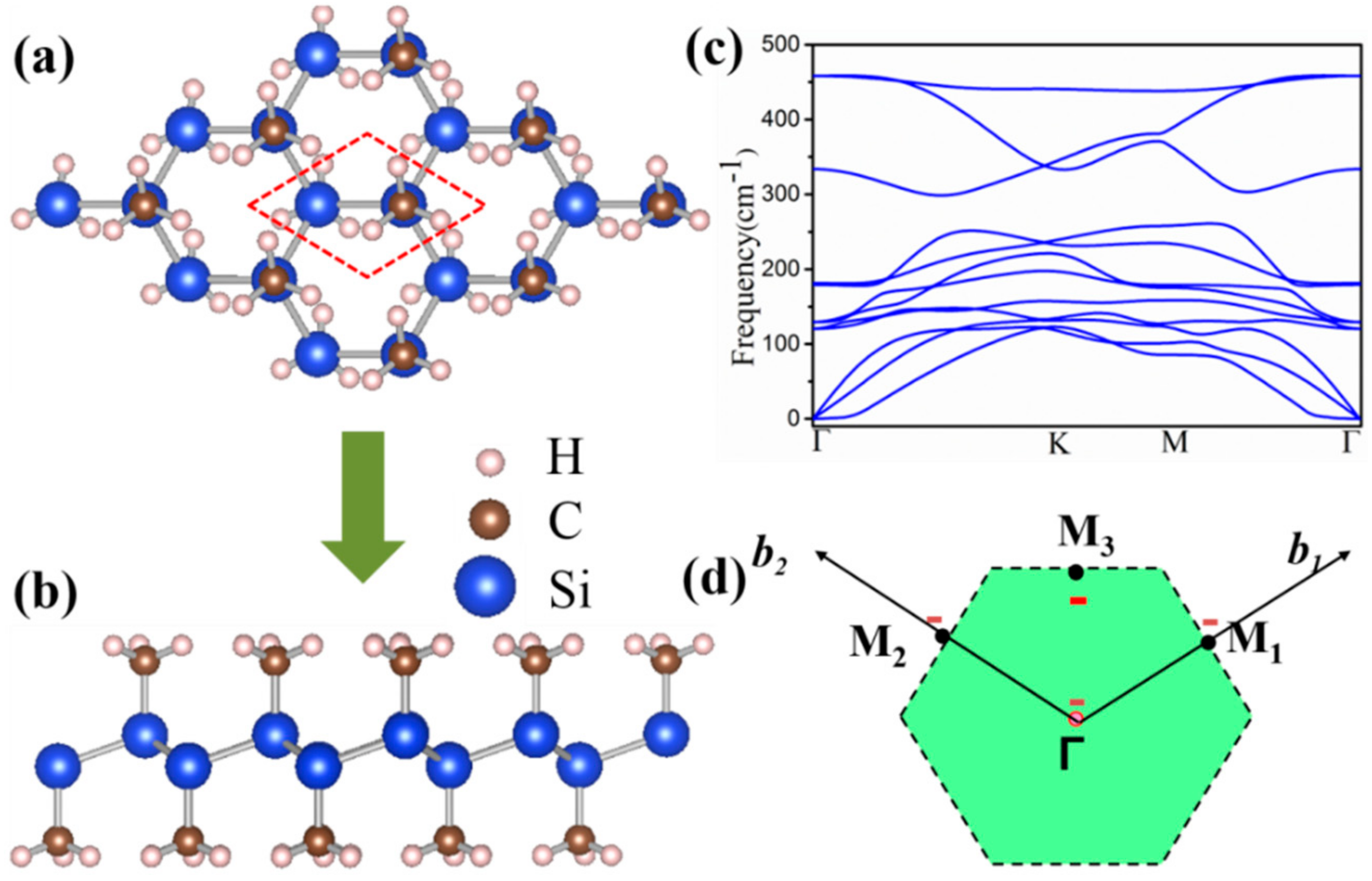
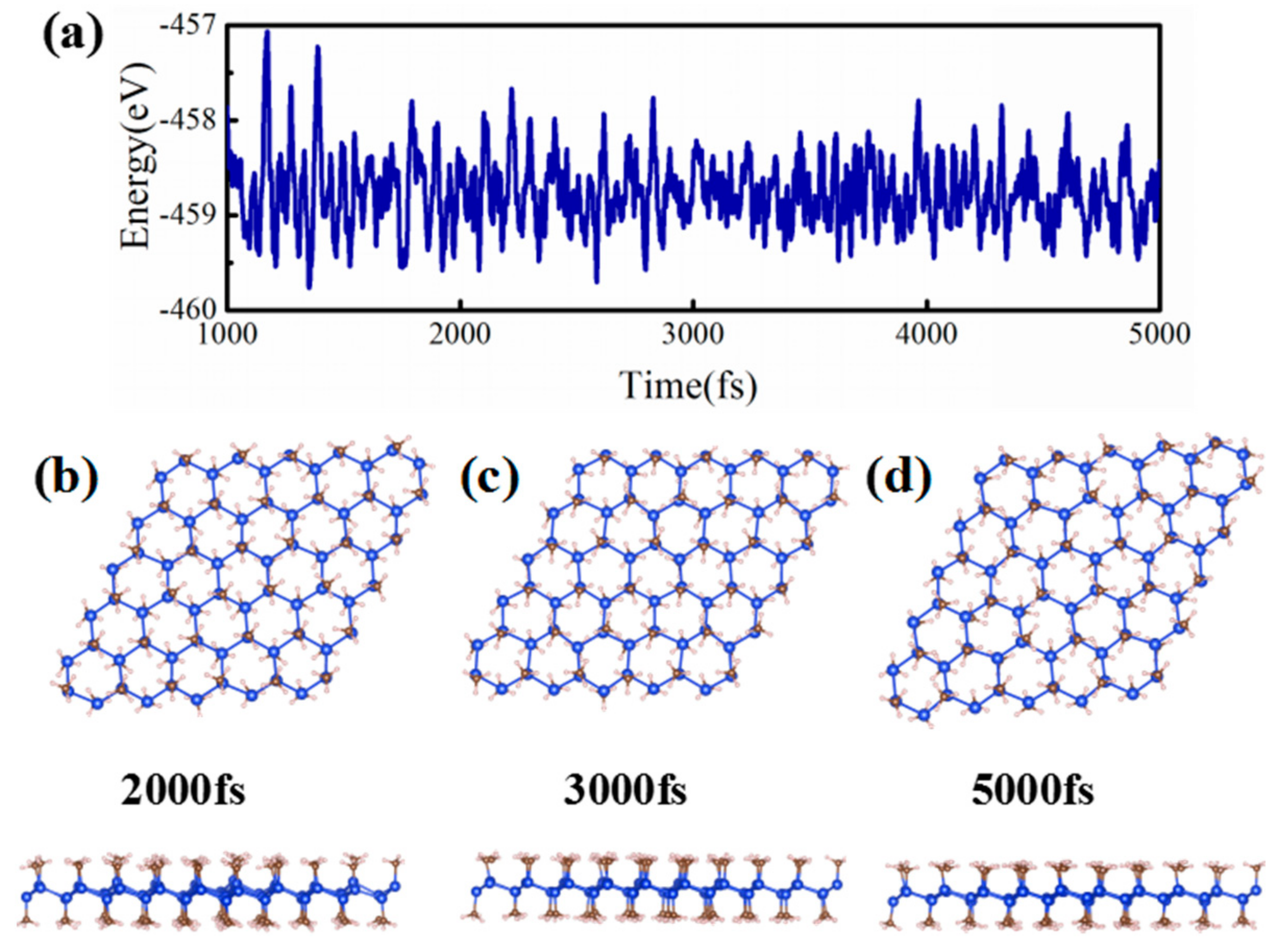
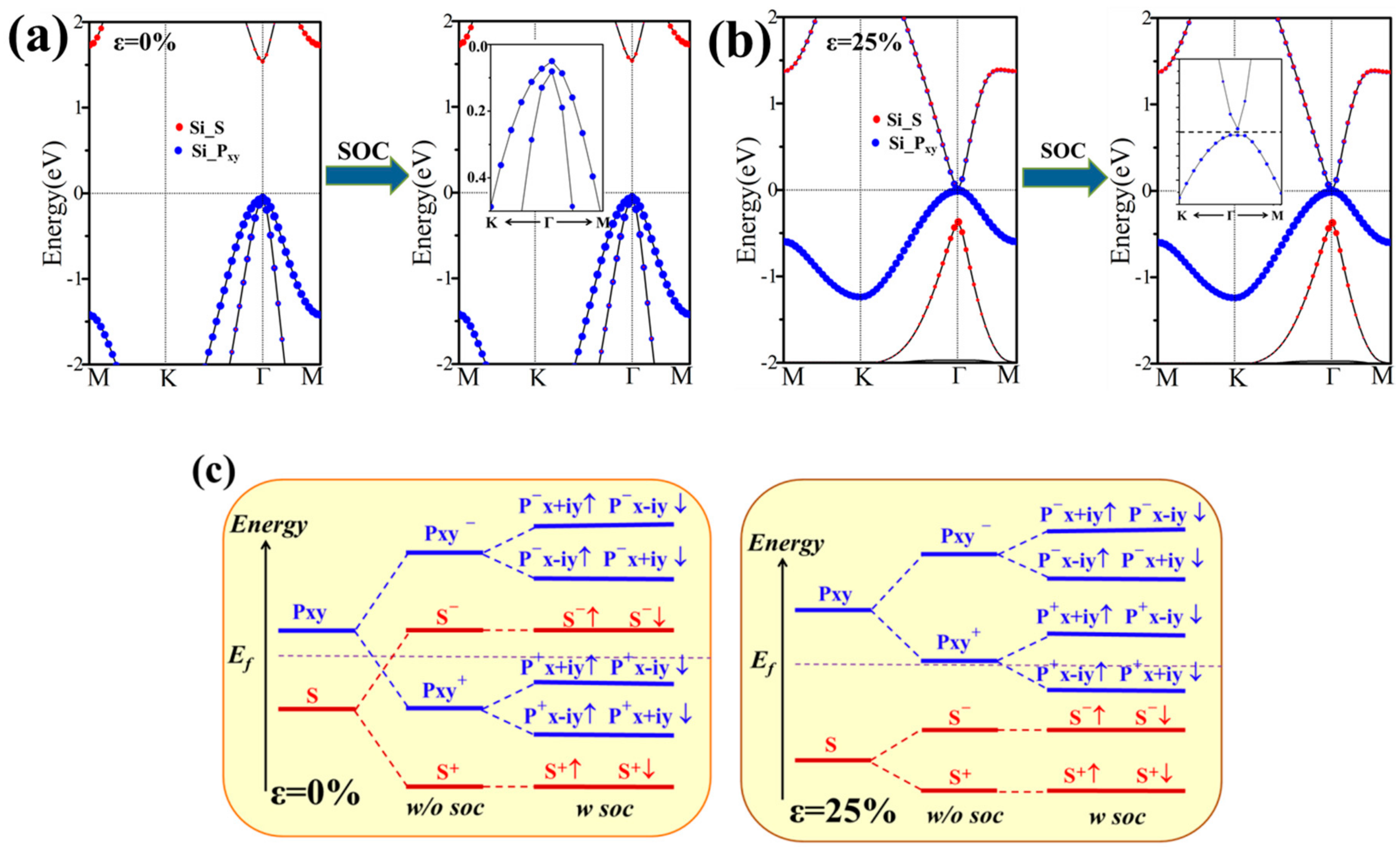

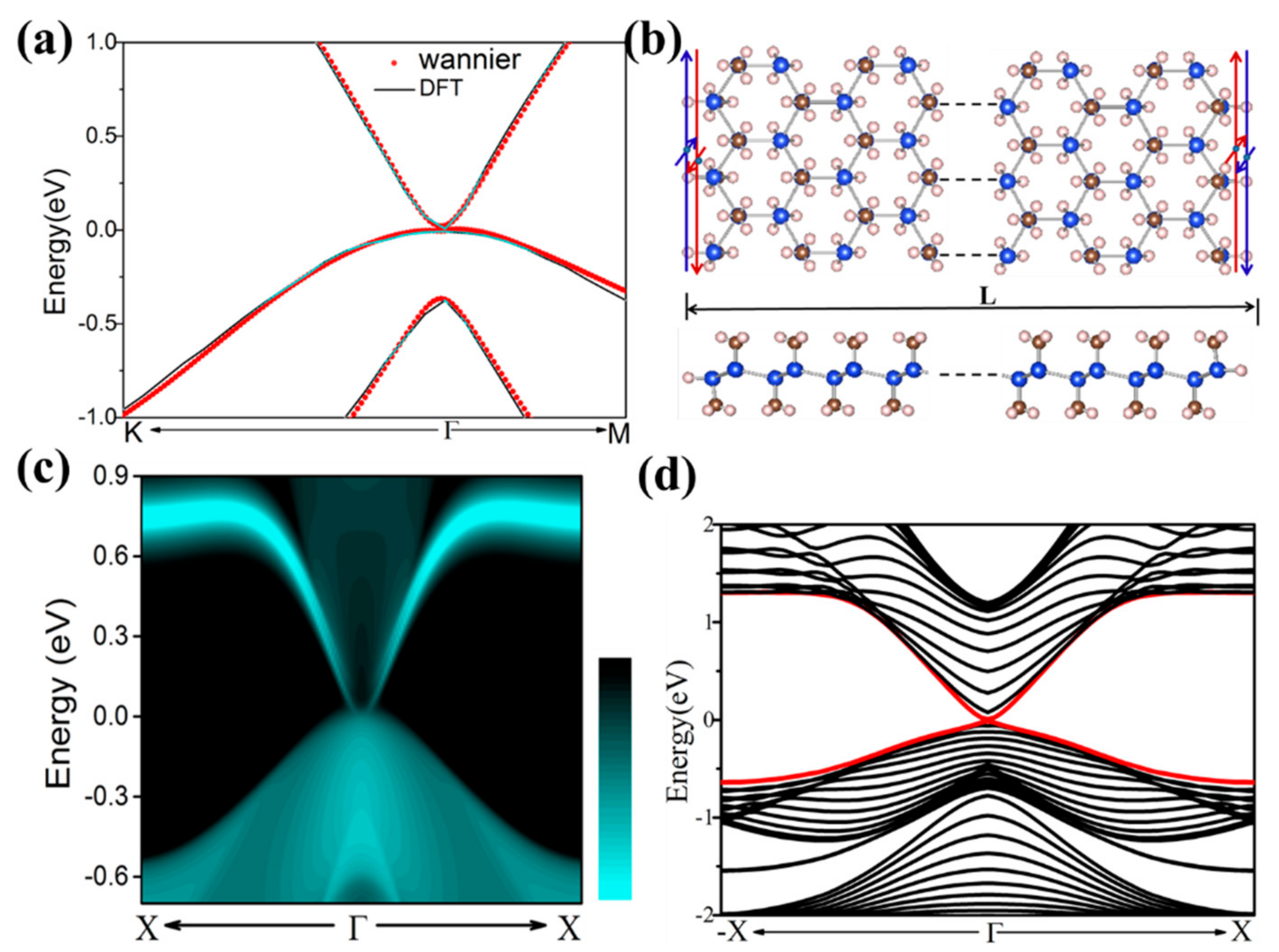
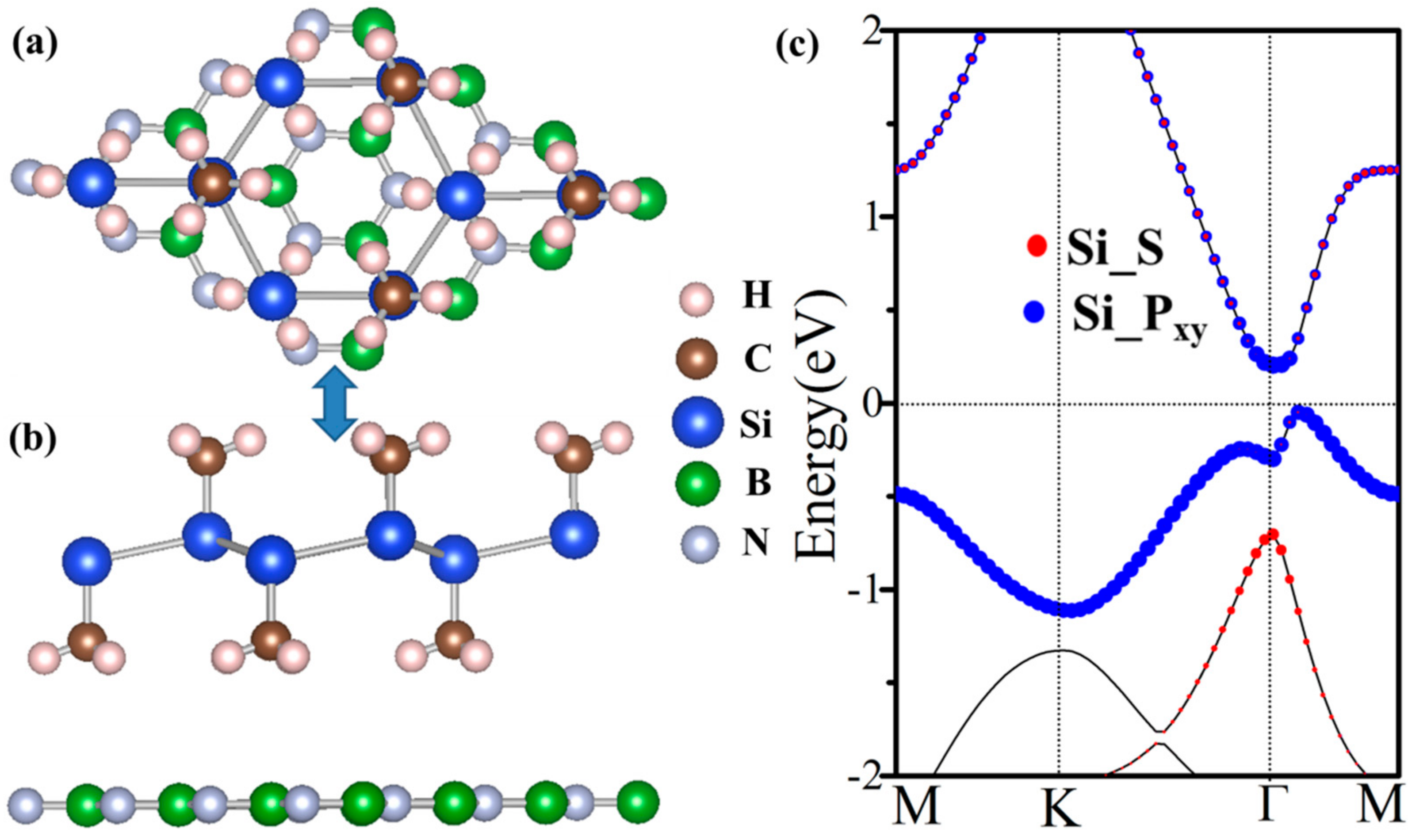
| Γi | Parity of ζ2n of Occupied Bands | δi | Γi | Parity of ζ2n of Occupied Bands | δi |
|---|---|---|---|---|---|
| (0.0, 0.0) | + − + − + + − − − + + | − | (0.0, 0.0) | + − + − + + + − − + + | + |
| (0.5, 0.0) | + − + − + − + − − + + | − | (0.5, 0.0) | + − + − + − + − − + + | − |
| (0.0, 0.5) | + − + − + − + − − + + | − | (0.0, 0.5) | + − + − + − + − − + + | − |
| (0.5, 0.5) | + − + − + − + − − + + | − | (0.5, 0.5) | + − + − + − + − − + + | − |
| ε = 0% | Z2 topological invariant | ν = 0 | ε = 25% | Z2 topological invariant | ν = 1 |
© 2018 by the authors. Licensee MDPI, Basel, Switzerland. This article is an open access article distributed under the terms and conditions of the Creative Commons Attribution (CC BY) license (http://creativecommons.org/licenses/by/4.0/).
Share and Cite
Ren, C.-C.; Ji, W.-X.; Zhang, S.-F.; Zhang, C.-W.; Li, P.; Wang, P.-J. Strain-Induced Quantum Spin Hall Effect in Two-Dimensional Methyl-Functionalized Silicene SiCH3. Nanomaterials 2018, 8, 698. https://doi.org/10.3390/nano8090698
Ren C-C, Ji W-X, Zhang S-F, Zhang C-W, Li P, Wang P-J. Strain-Induced Quantum Spin Hall Effect in Two-Dimensional Methyl-Functionalized Silicene SiCH3. Nanomaterials. 2018; 8(9):698. https://doi.org/10.3390/nano8090698
Chicago/Turabian StyleRen, Ceng-Ceng, Wei-Xiao Ji, Shu-Feng Zhang, Chang-Wen Zhang, Ping Li, and Pei-Ji Wang. 2018. "Strain-Induced Quantum Spin Hall Effect in Two-Dimensional Methyl-Functionalized Silicene SiCH3" Nanomaterials 8, no. 9: 698. https://doi.org/10.3390/nano8090698
APA StyleRen, C.-C., Ji, W.-X., Zhang, S.-F., Zhang, C.-W., Li, P., & Wang, P.-J. (2018). Strain-Induced Quantum Spin Hall Effect in Two-Dimensional Methyl-Functionalized Silicene SiCH3. Nanomaterials, 8(9), 698. https://doi.org/10.3390/nano8090698





